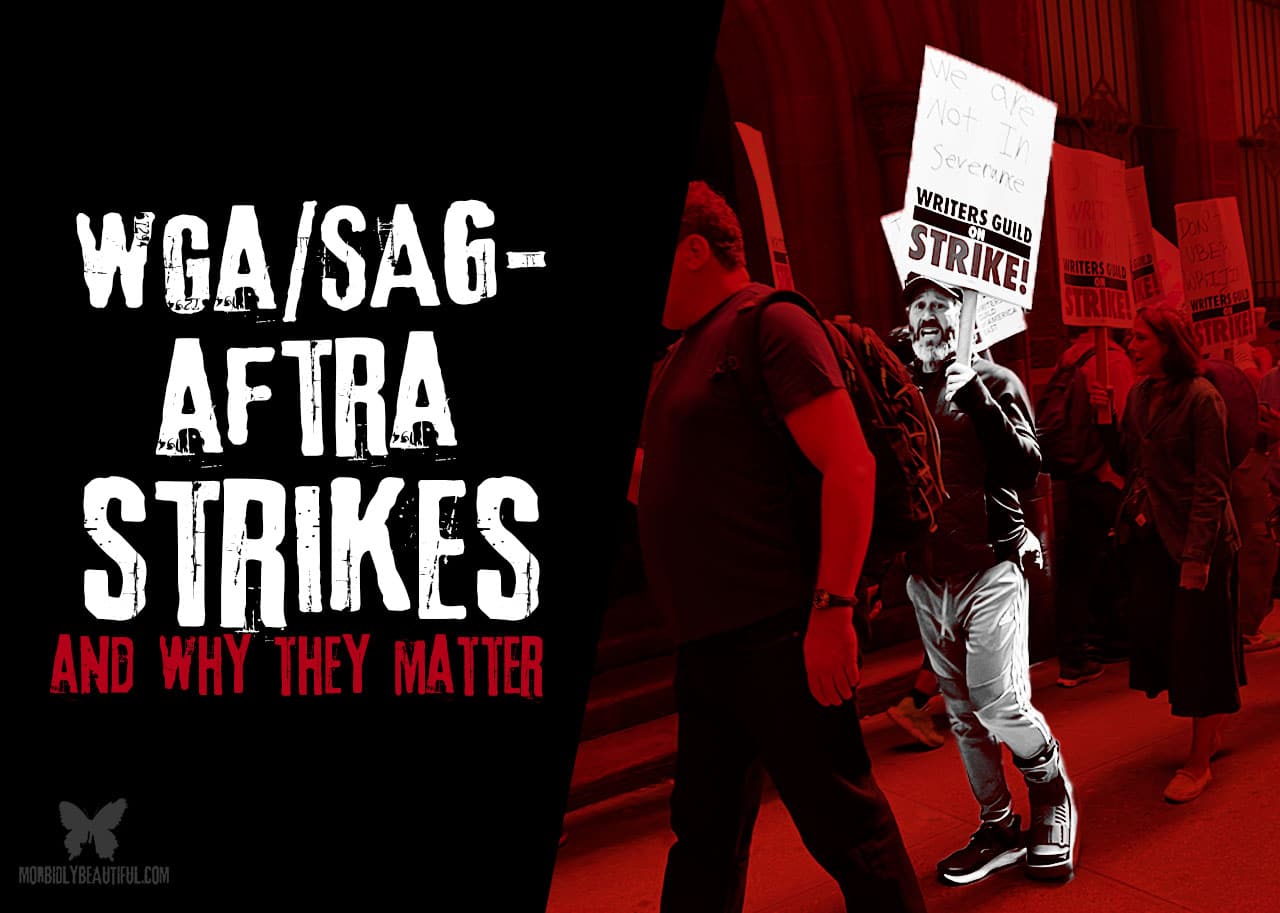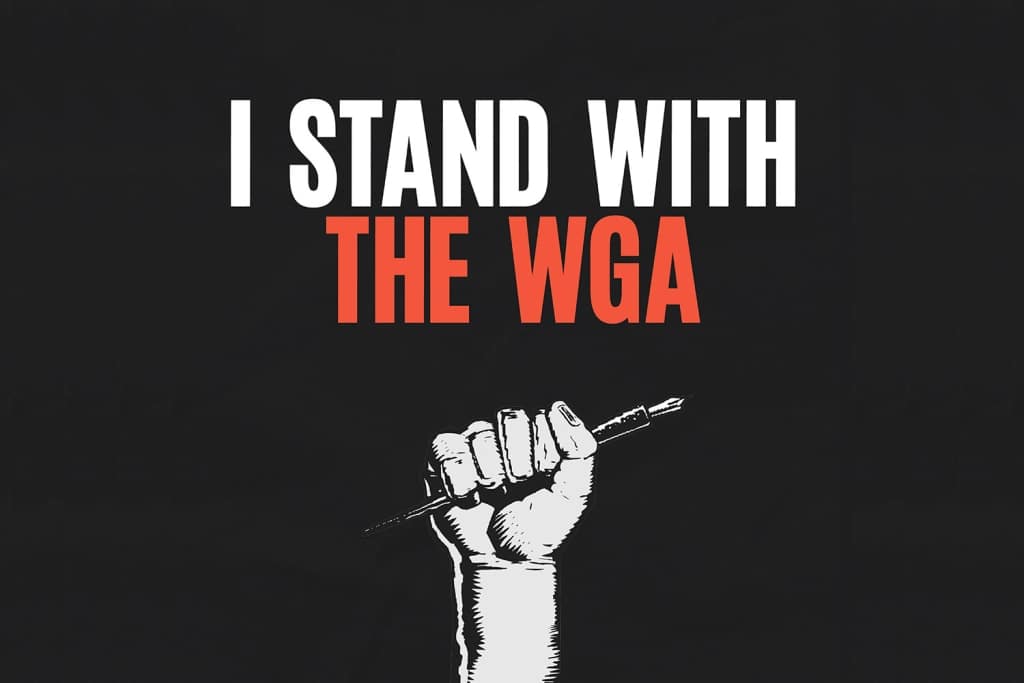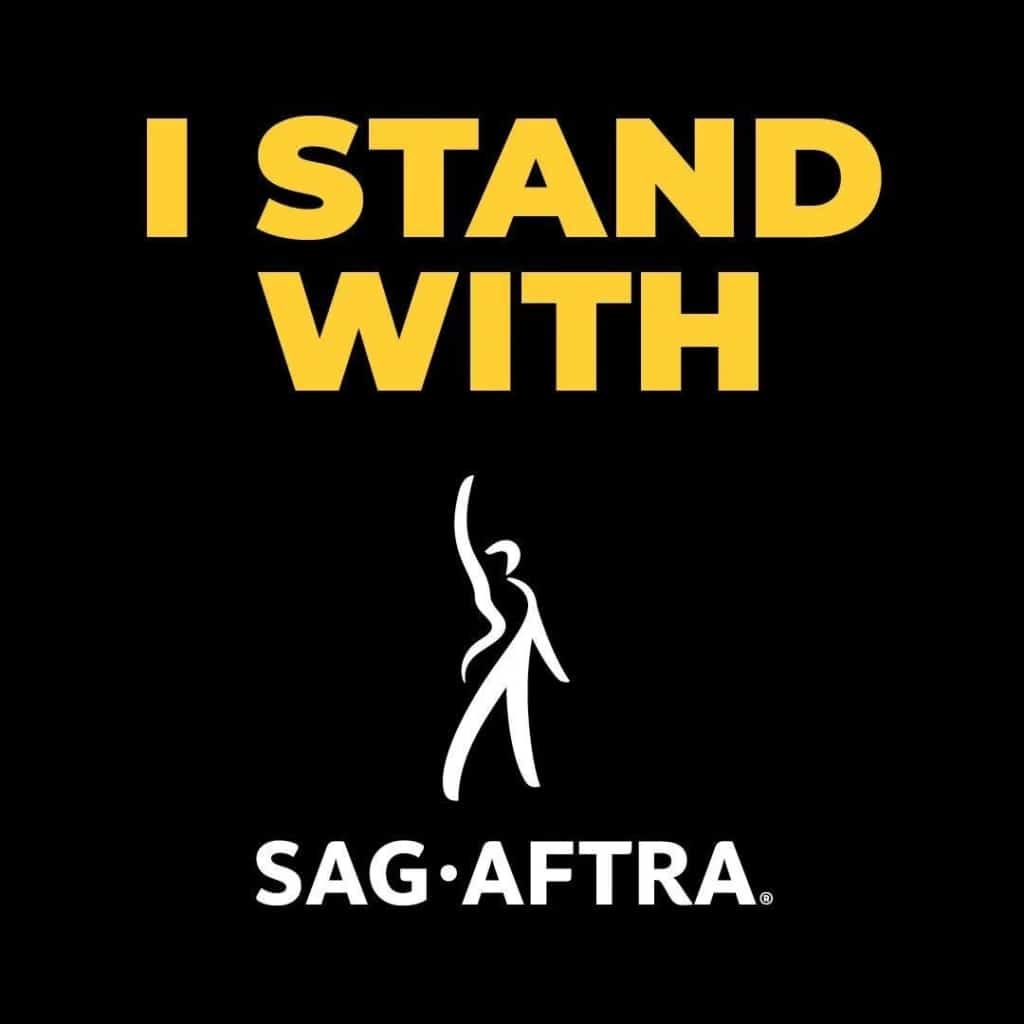We break down everything you need to know about the historic joint WGA and SAG-AFTRA strikes, plus how you can help support these creators.
When the Writers Guild of America published their official strike announcement, it made the existential nature of their fight clear:
“The companies’ behavior has created a gig economy inside a union workforce,” they told their members, “and their immovable stance in this negotiation has betrayed a commitment to further devaluing the profession of writing. […T]hey have closed the door on their labor force and opened the door to writing as an entirely freelance profession.”
WHAT’S HAPPENING AND WHY
As of July 14, the Screen Actors Guild – American Federation of Television and Radio Artists (SAG-AFTRA) is on strike, joining a two-month-long picket movement started by the Writers Guild of America (WGA), the national organization representing television and film screenwriters across the U.S.
The Writers Guild of America (WGA) voted to call an industry strike on May 1, following six weeks of failed contract negotiations with the Alliance of Motion Picture and Television Producers (AMPTP).
The last time there was a writers strike, in 2007-2008, work stopped for 100 days and cost $2.1 billion to California’s economy alone. Meanwhile, according to the WGA’s calculations, industry profits have ballooned from $5 billion in 2000 to $28-$30 billion from 2017-2021.
SAG-AFTRA’s demands for a fair contract with the AMPTP — including fair pay and restrictions on the use of AI — resulted in a similar standstill.
The WGA currently represents 11,500 writers across the entertainment industry. SAG-AFTRA represents 160,000 actors, announcers, broadcast journalists, dancers, DJs, news writers, news editors, program hosts, puppeteers, recording artists, singers, stunt performers, voiceover artists, and other media professionals — including some content creators.
Under strike rules, WGA members have ceased all work on current shows and won’t go into negotiations on future projects. For some, that also means they’ve stopped getting paid, and others will also lose crucial benefits should the strike continue.
SAG-AFTRA members also face complex restrictions on work and pay, including the inability to promote work in interviews, on red carpets and film festivals, and on social media.
The effects of a prolonged strike will be felt by more than writers and onscreen talent.
As productions halt, so will the opportunities for other industry workers, including cinematographers, hair and makeup teams, and countless others.
Just as a majority of exhibitors are getting back on their feet financially after Covid’s great shutdown of 2020-21, the historic joint WGA writers’ and SAG-AFTRA actors’ strike could have a devastating impact on a beleaguered industry — especially if the strike lasts for more than four months.
While we all hope for a swift and agreeable resolution, the industry is bracing for a long negotiation.
The longest WGA strike on record was 1988 (March 7-August 7), lasting 153 days, followed by the 1960 strike at 146 days (Jan. 16-June 10), and then the 2007-08 strike (November 5, 2007-February 17, 2008) at 100 days.
Streamers have a large back supply of product, meaning they have less incentive to move quickly and try to resolve the conflict. This strike also gives them the opportunity to slash bloated spending and kill bad deals. Motion picture studios also stand to save millions by stopping production for an earnings quarter.
However, the delay could eventually cause problems similar to what we saw in the aftermath of the pandemic.
That left the late August-October 2022 box office and early winter this year a dry bed for new content. Unfortunately, that could hurt the fledging theaters more than the deep-pocketed major studios, many of whom have already shifted a large part of their profit base to streaming platforms.
WHY YOU SHOULD CARE
The average moviegoer won’t notice an immediate impact on available new major title releases, given how far in advance these films are completed prior to their release. Many movies were not impacted by the WGA strike because scripts are typically written years in advance, and the moviemaking process does not require writers to be on set. (Though this is something the unions are fighting to change.)
Of course, movies need actors. And with SAG-AFTRA also on strike, that means most movies for major Hollywood studios will be shut down immediately.
Smaller movies that are publicity-dependent will likely start pulling releases in the near future, holding distribution until after the strike.
This is because actors are prevented from doing publicity on their feature or TV projects, which is likely to severely affect a studio’s ability to effectively market a film and generate audience excitement necessary to drive attendance at theaters.
The biggest immediate impact will be felt in the world of television. Expect long waits for new seasons of your favorite series and a significant shift in focus to reality-based shows over scripted programming.
The first effects of the WGA strike have already been felt in late-night variety and comedy shows like Saturday Night Live. This is because their scripts are written extremely close to when the show is shot (in some cases, on the same day). Without a script, the show cannot go on. Several show hosts, like Seth Meyers and Stephen Colbert are also members of the WGA and have voiced their support for the striking writers.
Shows in which writing staff are working on future episodes as the show is being shot will be hit next. The last time there was a writers strike, popular shows like The Office and Scrubs had to cut their seasons short.
That 2007-08 strike took place mid-season. This meant scripts for shows nearing the end of their seasons were being rushed into completion prior to the strike, as well as scripts for a potential fall premiere, in an attempt to keep interruption to a minimum.
But this rush had a significant impact on quality during this turbulent time.
The rise of streaming has made the impact of a strike less visible to those not working in the industry.
Many of the shows we watch now already have huge gaps between seasons. Many others stockpile scripts with a mini-room.
Reality (or “unscripted”) TV is hugely popular, and studios have typically leaned on it to fill programming holes in case of a strike. Though, it’s important to note that unscripted TV hours are grueling, and the people who make this programming have long considered their own organizing efforts, which would put more pressure on streamers and production companies.
In addition, there’s a massive pile of TV shows that you can watch if your favorite show is delayed. The streaming behemoth Netflix has also found huge success with international programming and could import more from writers who aren’t WGA members.
In short, the streaming services themselves are poised to be affected least since their libraries of content could carry them through a prolonged strike. They could even get a cash boost, as they did during the pandemic when production was halted.
That, of course, is part of the issue at hand, as streaming has significantly changed the game in a way that requires an entirely new paradigm shift in how writers and performers are paid.
The pandemic forced studios to sell off big titles to streaming, and that streaming boom has created much of the profit inequity at the heart of these strikes.
Both the WGA and SAF-AFTRA are striking against streamers and movie studios over pay, employment levels, and the changing way in which shows and movies are distributed.
Technology always introduces uncertainty and change in Hollywood, and the WGA is working hard to protect its membership against two seismic technical changes: the prevalence of streaming and the looming challenge of AI, both of which are leaving many writers struggling to survive.
Spending on original streaming content grew from $5 billion in 2019 to $19 billion in 2023 — the lion’s share of it by Netflix, which reported $6 billion in operating profits in 2021 and $5.6 billion in 2022.
In order to sustain this growth, streaming platforms need a constant stream of content to attract and retain subscribers. For a few years, that meant that Hollywood’s writers had been kept very busy, and new series were ordered all the time. In theory, this meant more jobs for writers.
However, in spite of increased work, wages have been deflated in an effort to cut costs. While budgets allotted to productions have risen substantially, the amount that writers in those jobs earn has gone down, in some cases quite significantly.
According to a bulletin that the WGA produced this spring ahead of negotiations, the average writer-producer pay — many writers working in TV pick up a producer credit as well — has actually declined 4 percent over the past decade.
If you adjust that for inflation, it’s a 23 percent decline in pay for television writers.
There are many complex reasons for this.
Most TV shows on streaming have far shorter seasons than their broadcast cousins — 8 or 10 episodes, as opposed to 22 or more — and that means writers get paid less for each job. The space between seasons can also be very long, forcing writers to face long periods without pay.
Another hot-button issue is the advent of the “mini room,” in which fewer writers than usual (two or three instead of the usual seven or eight) are hired to write a number of episodes of a show before it’s even picked up for production.
The writers in mini rooms generally are paid less than they would be in a regular writers room. The mini-room model aims to make writers as disposable as possible, and it keeps them from gaining valuable experience during actual production (thus severely limiting growth potential in their career).
Another huge issue is streaming residuals. When streaming first became part of WGA contracts 15 years ago, people thought of streaming as “TV on a computer,” something only a few people would ever really want.
In 2007-08, when the guild last went on strike, streaming residuals were one of the main issues being negotiated. Back then, the offer on the table to writers was absolutely nothing.
Even though many shows are now written exclusively for streamers, the residuals on streaming are much lower than in broadcast TV. If you write on a broadcast show, and it’s a huge success, then you get extra payment. That’s because your show helps bring in more viewers, which results in more ad spend and cable subscriptions.
But if you write on a show that is a huge hit for a platform like Netflix — think Stranger Things or Wednesday, even though it results in thousands of new subscribers and revenue for the platform, you don’t share at all in that profit.
As for screenwriters who work in movies, they are facing their own problems.
Primarily, there’s the fact that median screenwriter pay is the same as it was in 2018, and when you factor in inflation, that means it’s declined by 14 percent.
The WGA also found that writers who were paid less than $150,000 for their screenplays were asked to do more unpaid rewrites than those paid more for their screenplays.
As for the studios, they are citing tough economic conditions as the reason they can’t raise minimums or residuals. But both the WGA and SAG-AFTRA take issue with that claim — and for good reason.
In their bulletin, they note that “in sharp contrast to the diminishing compensation paid to our members, the studios are posting immense profits with a bullish outlook as demonstrated by lavish corporate executive compensation.
It’s worth noting that the average pay for a top Hollywood executive was $28 million in 2021, a hike of 53 percent from 2018. Disney CEO Bob Iger, who called the actors’ demands “not realistic” on TV on the morning the strike was called, recently signed a contract to run the company through 2026 and makes about $27 million a year.
On top of that, an anonymous studio executive told a Deadline reporter that with the writers strike, “the endgame is to allow things to drag on until union members start losing their apartments and losing their houses.”
In contrast to the ’07 strike, there has been tremendous union solidarity this time around. The WGA, Teamsters, IATSE (which covers on-set tradespeople, such as electricians and greens people), and the Directors Guild (which ratified its own contract in June) issued a statement expressing solidarity with SAG-AFTRA.
This isn’t only about fair compensation; the issue of AI is another serious sticking point.
AI is a rising threat to the livelihood of writers in particular.
Because of the formulaic nature of many television episodes and movies produced by Hollywood, it’s not hard to imagine a scenario in which an AI tool is used to generate an idea for a plot, or even a full script, which could then be punched up and revised by a writer at a much lower cost to the studio.
Further, since AIs currently are incapable of distinguishing between copyrighted and freely available material, the potential for rights infringement is huge.
But more importantly, the biggest issue is whether AI poses threats we haven’t even begun to imagine.
Part of the reason the WGA is having such a battle with streaming is that nobody quite realized how the technology would morph and change or how dominant it would become in such a short span of time.
AI has the potential to have a far bigger impact, reducing not only writers’ pay but potentially eliminating many jobs altogether.
The WGA can’t slow or stop the technology, but it can provide protections now to help minimize the impact and ensure basic standards of human involvement.
In negotiations prior to the strike, the AMPTP refused the WGA’s demands around AI, instead countering with “annual meetings to discuss advancements in technology.”
Meanwhile, the actors have their own legitimate concerns about the rise of AI. The biggest issue is the use of their likenesses and voices, which AI is increasingly able to imitate.
HOW CAN YOU HELP?
As a consumer of film and television, there are important ways you can support the SAG-AFTRA and WGA writers’ strikes.
One of the most impactful things an average person can do to support these talented creatives responsible for bringing us the content we love is to donate to their cause. Members of the unions can’t keep working while on strike, so the organizations have funds to help provide struggling actors and writers with financial assistance while away from their jobs.
SAG-AFTRA links to an Emergency Financial Assistance and Disaster Relief Fund on its website, while WGA has Good and Welfare Emergency Assistance Loans for its writers. The Entertainment Community Fund is also helping assist those on strike.
It’s important to note that the vast majority of SAG-AFTRA members do not constitute the wealthy elite, are not swimming in cash, and often fall into the category of the struggling middle class. Around 87% of SAG members do not even reach the threshold of $26,000 annually in paid SAG-eligible work (the amount required to receive health care benefits under SAG).
According to the Guardian, only 2% of actors make a living solely from their acting gigs. The average yearly pay for a SAG-AFTRA actor in the United States is approximately $40,000, which is 31% below the national average.
The members of the WGA tend to fare a bit better, with higher average salaries. The WGA has not released a median annual figure since 2014, when it was $140,000 (in 2021 dollars). But the average earnings do not account for the sizable number of WGA members who, in any given year, earn nothing from writing.
Further, The Hollywood Reporter published an article discussing a new report released by the Writers Guild of America West (WGAW), which suggests that the organization’s members are falling behind in earnings and opportunities in the streaming industry.
The report found that although streaming platforms such as Netflix, Amazon, and Hulu have been expanding, the compensation for writers on these platforms has not kept pace with the growth.
Shorter seasons and lower pay are putting many writers in precarious situations.
In addition to donating, or if donating is not an option, you can also post your vocal support on social media.
The actors union has said it considers a content creator or up-and-coming actor taking a job that would normally be filled by a union member crossing the picket line.
Neither union has called on supporters to stop streaming their favorite shows or going to movie theaters — they don’t consider such commonplace activities to be crossing the picket line, the Washington Post reported.Visit the guilds’ strike pages to learn more and stay up to date on the WGA and SAG-AFTRA strikes.

























Follow Us!